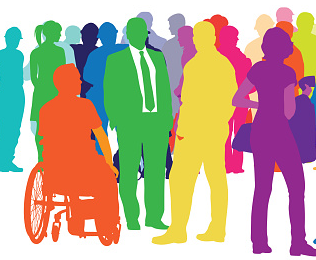By Jacopo DeMarinis
We at CAPA UIUC dedicate a lot of our activist efforts to promoting awareness of social and economic inequities, as well as the climate crisis, and campaigning for social justice and action on climate change. As previous blog posts have made clear, unjust social and economic conditions, exacerbated by climate change, play an important role in driving conflict. But they are not the only factors at play!
Destructive conflict can also frequently arise due to a pattern of violent and destructive communication, as we are seeing in the United States with political polarization. We all know what destructive and violent communication looks like; we see it on TV, have witnessed it frequently in our daily life, and probably have engaged in a pattern of violent communication with others at one point or another. So, what does nonviolent communication look like?
Dr. Marshall Rosenberg, a prominent mediator, teacher, psychologist, conflict scholar, and the founder of the Center for Nonviolent Communication, popularized this concept by developing a method for nonviolent communication that laid the foundation for a reconciliatory, constructive way to communicate with others.
As depicted above, the nonviolent communication model (NVC model) is rooted in 2 main ideas: empathetically listening and honestly expressing. When people are communicating nonviolently, they are engaging compassionately, actively listening to perceive the other person’s needs and feelings, and honestly conveying their feelings and needs as well. According to Dr. Rosenberg, the NVC process consists of 4 steps:
- Observations, where we actively observe how our surroundings, including others’ actions, are affecting us, or how others are reacting to their surroundings and our actions.
- Feelings, where we translate our observations into corresponding feelings; does what we observe upset us, make us happy, etc.? Furthermore, we listen and observe others’ feelings as expressed through the community- verbal or nonverbal.
- Needs, where we identify our specific needs as they relate to our feelings, or observe the needs of others. For example, “I am defensive because I am observing that you are judging me, and I really need you to just accept me as I am right now.”
- Requests, where we request a specific action from another person, which is connected to our observations, feelings, and needs. If the person complies with this request, it would have a very positive impact on your relationship and life. For example, the “request” in the example above was that the other person accept you.
Marshall Rosenberg employed the NVC process that he created throughout his work in conflict-affected countries all over the world, including in Israel and Palestine, Croatia, Nigeria, Rwanda, and Sierra Leone. Importantly, this process is very applicable to a wide variety of contexts. You can use this communication model to understand your feelings and needs more deeply, foster stronger and more compassionate relationships with others, handle workplace conflicts, relate with people of different political and cultural identities, or help others resolve disputes as a mediator or facilitator.
Furthermore, there are several things to keep in mind when we are following the NVC model:
- Consciousness: Am I in tune with my feelings and needs, as well as those of others? Am I actively and empathetically listening and honestly expressing myself? Do I value solutions that fulfill the needs of others, as well as myself?
- Thought: Are my thoughts judgemental or angry toward the person with whom I am communicating? How can I reframe my thoughts so that they emerge from a place of love?
- Language: Do my words convey judgment or blame?
- (Nonverbal) Communication: Do nonverbal elements of my communication- body language, tone and pitch of voice, etc.- convey judgment or blame?
- Use of Power: What are my intentions and goals regarding this communication? Do I seek to establish power over, instead of power with, the person with whom I am engaging, or do I value their needs as much as I value my own? Am I willing to converse with this person until we find a solution and establish an understanding that works for both of us?
Importantly, the NVC model has some key values and assumptions:
- Universal Human Needs: The Center for Nonviolent Communication defines human needs as “the energy in living organisms that compels them to seek fulfillment and to thrive.” Different universal human needs include: a) Connection, b) Physical Well-being, c) Honesty, d) Play, e) Peace, f), Autonomy, and g) Meaning. Furthermore, since all of our actions are “attempts to meet our needs,” we can better understand others’ actions and the understanding that all share a desire to comply with our needs is a way in which we can foster more compassion for others and build common ground with them. We will discuss the importance of human needs in later chapters.
- Connection First: Defined as “the moment in which two people experience what is alive in each other simultaneously,” the Center views connection as an extremely important experience that, when engaged in empathetically, can give rise to solutions that meet everyone’s needs peacefully.
- The Need for Contribution: Contributing to others’ lives in a way that enhances their well being is an important universal human need. NVC is conducive to this desire since it allows people to convey their needs to others that are willing to receive their request. Furthermore, when you are disconnected from your “need for contribution,” seeking empathetic connection with others or listening to yourself and your needs can help you regain this motivation.
- Interdependence: Since all human beings are interconnected, one’s actions have ripple effects that influence the whole world. Furthermore, our socio political and economic systems are all connected in this ever globalized world.
- Value Judgements: In accordance with NVC, it is vital to judge actions and situations by comparing them with our basic values, rather than characterizing them according to our simple moral beliefs- i.e., “terrorists are evil.” In other words, judge by reaffirming our commitment to compassion and peace instead of emphasizing our condemnation of evil, which further justifies violence against the aggressor.
- The Protective Use of Force: Kind of like self defense, the use of force is only acceptable as a way to protect ourselves, rather than inflict unnecessary harm. Restorative justice and nonviolent education are acceptable ways to restore community cohesion when violence occurs, rather than retributive justice.
The Center for Nonviolent Communication has also published a list of different feelings and needs to assist NVC participants in identifying their needs and feelings when engaging in the NVC process. We encourage you to check out the complete list on the Center for Nonviolent Communication website!
One thing that’s important to note is that a fundamental assumption of the NVC method, that I happen to agree with, is that people ultimately crave compassionate human connection and that anger and fear is a departure from our natural equilibrium of love and compassion. Thus, while this process might sound easy on paper, many times, due to the unmet needs and strong emotions that may beset conflict situations, it may be difficult to immediately gain the other person’s trust and willingness to collaboratively engage in this process. However, Rosenberg believes that the other person will eventually emulate the compassionate way in which you interact with them and that the desire to authentically and empathetically engage with others is in our DNA.
We at CAPA UIUC encourage you to read more into the wisdom of nonviolent communication (there’s a book Dr. Rosenberg wrote on nonviolent communication: Nonviolent Communication, a Language of Life!) and to try adopting the style of nonviolent communication as you interact with others, especially those who think and act differently from you. If we all do this and share the brilliance of nonviolent communication with others, we can make a big, tangible difference in the world by encouraging the peaceful and productive resolution of conflict. The adoption of NVC will also encourage people of different political views and cultural backgrounds to unite in pursuit of a more just world that meets everyone’s needs.
One person embracing NVC would be a small step, but a giant leap for humanity, as others will follow suit once realizing the immense benefits of NVC. So keep at it!
References
Rosenberg, Marshall. (n.d.). Nonviolent Communication: A Language of Life, The Heart of
Nonviolent Communication. The Center for Nonviolent Communication.
Walden, Myra. (n.d.). What is Nonviolent Communication? PuddleDancer Press.
ormation.pdf
Share this:
https://widgets.wp.com/likes/index.html?ver=20220105#blog_id=191470208&post_id=134&origin=chipeaceuiuc.wordpress.com&obj_id=191470208-134-61e19e75295d5Posted bycapauiucPosted inUncategorized

